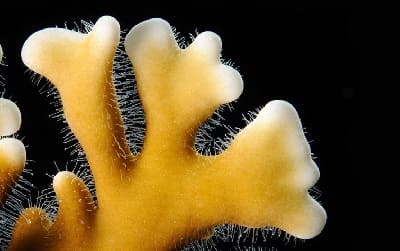Home › A to Z of Scuba › Diver Injuries › Fire Coral
First Aid for Fire Coral Sting
If human skin makes contact with Millepora alcicornis (also called sea ginger), it causes a painful burning sensation and a red rash that can last for a few days.
This help guide explains the common symptoms and first aid treatment for fire coral sting infection, and how to get rid of coral rash bumps.
What Will Happen If You Touch Fire Coral?
The Millepora alcicornis fire coral is part of the genus Millepora. You can find them in tropical and subtropical waters, worldwide.
In fact, fire corals are not typical coral structures by definition. Instead, they are colonial marine cnidarians.
The majority of fire coral species will have some brown or yellow-green rusty colouring and a stony branch-like formation.
As a result, touching any stinging cells of the 11,000 marine cnidarians with bare skin (e.g. jellyfish) will cause a severe reaction.
Being sessile creatures (not moving around), means scuba divers with poor buoyancy control, or accidental contact by snorkelers, is the most common reason for fire coral cuts, stings, and rashes.
Pro Tip: Even though you can identify the calcareous structure of Millepora alcicornis, these hydrozoans are more closely related to the Portuguese man-of-war species.
How to Prevent Fire Coral Scrapes
Mastering buoyancy control, such as in the Peak Performance Buoyancy Specialty course, is the best way for divers to avoid fire coral-related incidents. In addition, scuba divers and snorkelers should:
- Avoid touching all marine creatures (especially those with a calcareous structure).
- Be aware that fire corals colonise different types of hard surfaces (e.g. old conchs, rocks).
- Find a suitable sandy area where there are no delicate formations if there's a need to kneel down or stand on the bottom.
- Wear a full-body wetsuit for extra protection and always look around, as well as down below, when making a descent.
Fire Coral Sting Symptoms
In fact, the fiery sensation that divers and snorkelers experience after touching this species is how it got its name.
Cnydocites, embedded inside a calcareous skeleton, are the main reason for the burning sensations. They contain nematocysts that will fire stingers when someone touches them.
So, after dermal contact with fire corals (Millepora alcicornis), the release of the venom typically causes:
 A burning sensation that usually occurs within three or four minutes
A burning sensation that usually occurs within three or four minutes- Anaphylaxis (e.g. swelling of the tongue, face, or throat)
- Blisters (vesicles) and skin itching
- Fever
- Gastrointestinal or cardiovascular issues
- Nausea and vomiting (not common)
- Necrosis (death of body tissue)
- Stinging pain associated with raised, itchy wheals
- Swelling in the lymph glands
The sting severity can last for several hours or for several days in the worst cases. It usually leads to a red, bumpy skin rash. Fire coral stings can leave a scar similar to that of scarred skin tissue from scalding accidents.
Some of the most problematic fire coral injuries occur from a laceration or an open wound, resulting in an internal envenomation. In this case, medical intervention may be required to treat any serious soft tissue infection.
Treatment for Fire Coral Stings
The DAN™ diving association issues medical recommendations for treating common scuba diving injuries, including marine envenomation.
- Avoid puncturing any red blisters or vesicles that form. Instead, keep them aerated and allow them to dry out as much as possible. Seek medical attention for dermonecrotic issues or open cuts and wounds.
- Keep the victim as still and quiet as possible. Keep them reassured and do not let them walk around.
- Try to rinse the affected site with topical acetic acid, white household vinegar, or seawater to inactivate the toxin. It's important not to use freshwater because it usually increases the pain for the victim.
- Use gloves, tweezers, or sellotape to try and remove any visible parts. In some cases, it will be necessary to take antibiotics and a tetanus booster.
Pro Tip: As a dive centre operator, you'll have a duty of care for helping an injured diver. Use common sense and be prepared to have them evaluated by a medical professional.
Related Information and Help Guides
- Blue Ringed Octopus Bite Symptoms and First Aid
- Portuguese Man-of-War Sting Symptoms and Treatment
- Sea Snake Bite Symptoms and Medical Treatment
Note: The short tutorial video [presented by DAN] contains footage about the best first aid treatment for fire coral scrapes and stings.